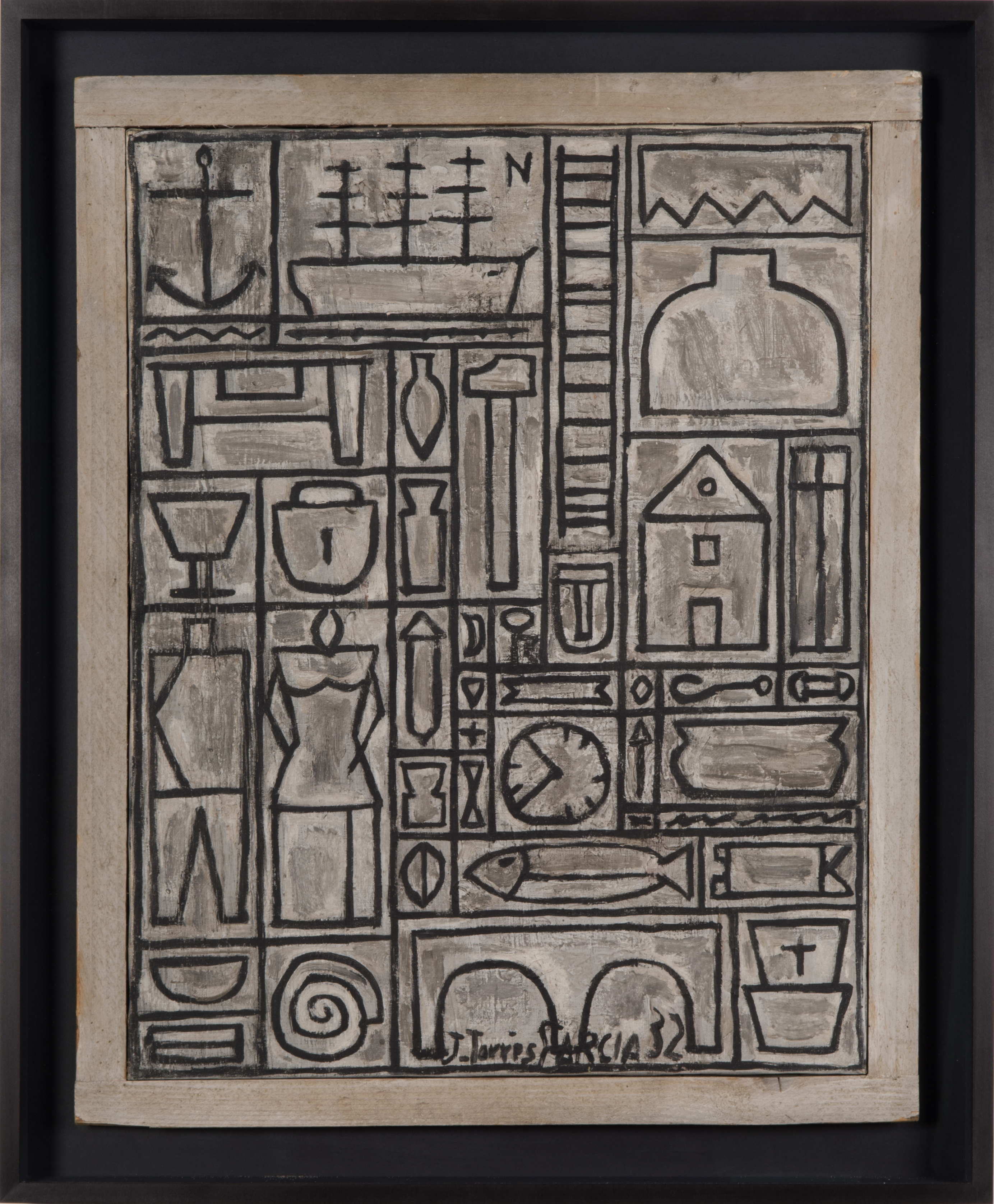Joaquin Torres-Garca traveled with his family to Catalonia, Spain, in 1891, and the following year they settled in Barcelona. There he studied at the Academia Baixas and the Escuela Oficial de Bellas Artes La Llotja. Torres-Garca worked as an illustrator and between 1903 and 1907 he collaborated with Antonio Gaud in the production of stained glass for the Baslica de la Sagrada Familia, in Barcelona, and the Cathedral of Palma de Mallorca. He identified the Catalan anti-modernist cultural movement noucentisme. Torres-Garca received several commissions for murals and interior decoration, including one for the Uruguayan pavilion at the Exposition Universelle et International in Brussels, in 1910, and another one for the Palau de la Generalitat in Barcelona, executed between 1911 and 1917.
During what was called his “crisis of the 17,” he distanced himself from noucentisme and its classical aestheticism, and his ideas about modern painting began to mature. He considered modern painting should be autonomous and not imitative. In 1917 Torres-Garca published the book Descubrimineto de s mismo, in which he presented his theoretical findings about modern art. He also exhibited his Composiciones vibracionistas, in which the dynamics of urban life were represented through vibrant contrasting colors and figures. These were shown with the works of fellow Uruguan painter Rafael Barradas at the Galeries Dalmau, in Barcelona. In 1918 Torres-Garca made his first wooden toys and he moved to New York to manufacture them in 1920. There, he exhibited urban landscapes that were geometric in character (Whitney Studio Club, 1921), but he did not receive a favorable critical response. He moved back to Europe where he opened a workshop in Italy (1922), in the south of France (1924) and finally in Paris (1926).
Until he settled in the French capital, Torres-Garca’s paintings, although modernist, were somewhat classical in style. In Paris he joined the avant-garde and became familiar with the latest cubist works and neoplasticism. At the time he fell under the spell of African and pre-Columbian art. Among his first constructivist works was a series of wood assemblages painted in oil that followed the influence of neoplasticism with their orthogonal structures and fields of brillilant color. In 1929 Torres-Garca cofounded the group Cercle et Carr and the magazine of the same name along with Piet Mondrian, Hans Arp, Luigi Russolo and Pere Daura. This group organized the first international exhibition of constructivist and abstract art in 1930. Shortly after the show the group dissolved.
In 1931 Torres-Garca presented a successful solo exhibition at the Galerie Jeanne Bucher (Paris). At this time, Torres-Garca struggled between the pull of nature and of abstraction, a problem for which he found a solution, combining the structure of neoplasticism’s painting with symbols producing a schematic image of reality. In 1932 he moved to Madrid, where he presented a retrospective exhibition at the Museo de Arte Moderno (1933).
In 1934 Torres-Garca returned to Montevideo, where he dedicated himself to further developing his theoretical framework creating a synthesis between geometric and constructivist aesthetics and the symbolism of pre-Columbian American cultures. He named his new style universalismo constructive.
Although Torres-Garca experimented with pure structures deprived of symbols and he did create a series of portraits, Hombres clebres, in 1939. He also created works for integration into the urban fabric among which was Monumento csmico constructivo (Parque Rod, Montevideo, 1938). In other works he worked on simplifying the symbols. His last compositions were characterized by a drastic reduction of the palette to primary colors.
Parallel to his creative work, he was intensely involved in education working on both the theoretical and practical fronts. He founded the Asociacin Arte Constructivo (1935) that published the magazine Circulo y cuadrado and he published books, including Universalismo constructivo. Contribucin a la unificacin del arte y la cultura de Amrica (1944). In 1944 he founded the Taller Torres-Garca, dedicated to education and collective work and he published the newspaper Removedor. During the 1940s Torres-Garca was the principal leader of artists and the pre-eminent art teacher in the Rio de La Plata region.
